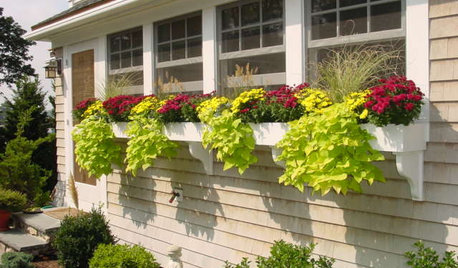White mold or fungus in soil? What's up?
rebeccita
15 years ago
Related Stories

HOUZZ TOURSHouzz Tour: A Texas Home Gets a Healthy, Fresh Start
Mold eradication was just the beginning for this Austin family's home on a creek bed — toxins of all kinds now don't make it past the door
Full Story
FALL GARDENING7 Reasons Not to Clean Up Your Fall Garden
Before you pluck and rake, consider wildlife, the health of your plants and your own right to relax
Full Story
HOUSEPLANTSPlay Up Some Fiddleleaf Figs for a Lively Indoor Tune
Strike a dramatic chord in a minimalist scene or a country note in a rustic setting — fiddleleaf fig plants harmonize with any style
Full Story
MOST POPULARThe Polite House: On ‘No Shoes’ Rules and Breaking Up With Contractors
Emily Post’s great-great-granddaughter gives us advice on no-shoes policies and how to graciously decline a contractor’s bid
Full Story
GARDENING AND LANDSCAPINGCharm Up Your House With Windowboxes
Plant Some Living Color Right Outside Your Window
Full Story
GARDENING GUIDESGreat Design Plant: Amelanchier Signals Spring With Airy White Blooms
With roughly 20 species of serviceberry native to the U.S., bees can feed on the early-season blooms while birds enjoy the summer berries
Full Story
COLORColor of the Year: Off-White Is On Trend for 2016
See why four paint brands have chosen a shade of white as their hot hue for the new year
Full Story
BEDROOMS11 Reasons to Love White Bedding
For easy bedding that makes neutrals sing and accessories pop, look to the white side
Full Story
GARDENING GUIDESNew Ways to Think About All That Mulch in the Garden
Before you go making a mountain out of a mulch hill, learn the facts about what your plants and soil really want
Full Story
FALL GARDENING5 Ways to Put Fall Leaves to Work in Your Garden
Improve your soil and yard the organic way with a valuable garden booster that grows on trees
Full Story





Kimmsr
Related Professionals
Marco Island Landscape Architects & Landscape Designers · Middle Island Landscape Architects & Landscape Designers · Brentwood Landscape Contractors · Peabody Landscape Contractors · Americus Landscape Contractors · Amesbury Landscape Contractors · Belvedere Park Landscape Contractors · Bethel Park Landscape Contractors · Cliffside Park Landscape Contractors · Mastic Beach Landscape Contractors · Mastic Beach Landscape Contractors · Raleigh Landscape Contractors · Seminole Landscape Contractors · Casselberry Landscape Contractors · Lincolnton Decks, Patios & Outdoor Enclosures